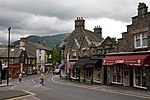Stagshaw Garden
Cumbria geography stubsGardens in CumbriaNational Trust properties in the Lake DistrictSouth Lakeland DistrictWoodland gardens

Stagshaw Garden is a woodland garden situated south of Ambleside, in Cumbria, England, and in the ownership of the National Trust.The garden is noted for its shrubs, including rhododendrons, azaleas and camellias.
Excerpt from the Wikipedia article Stagshaw Garden (License: CC BY-SA 3.0, Authors, Images).Stagshaw Garden
Lake Road, South Lakeland Waterhead
Geographical coordinates (GPS) Address Website External links Nearby Places Show on map
Geographical coordinates (GPS)
| Latitude | Longitude |
|---|---|
| N 54.4182 ° | E -2.9561 ° |
Address
Stag Shaw Gardens
Lake Road
LA22 0EX South Lakeland, Waterhead
England, United Kingdom
Open on Google Maps










